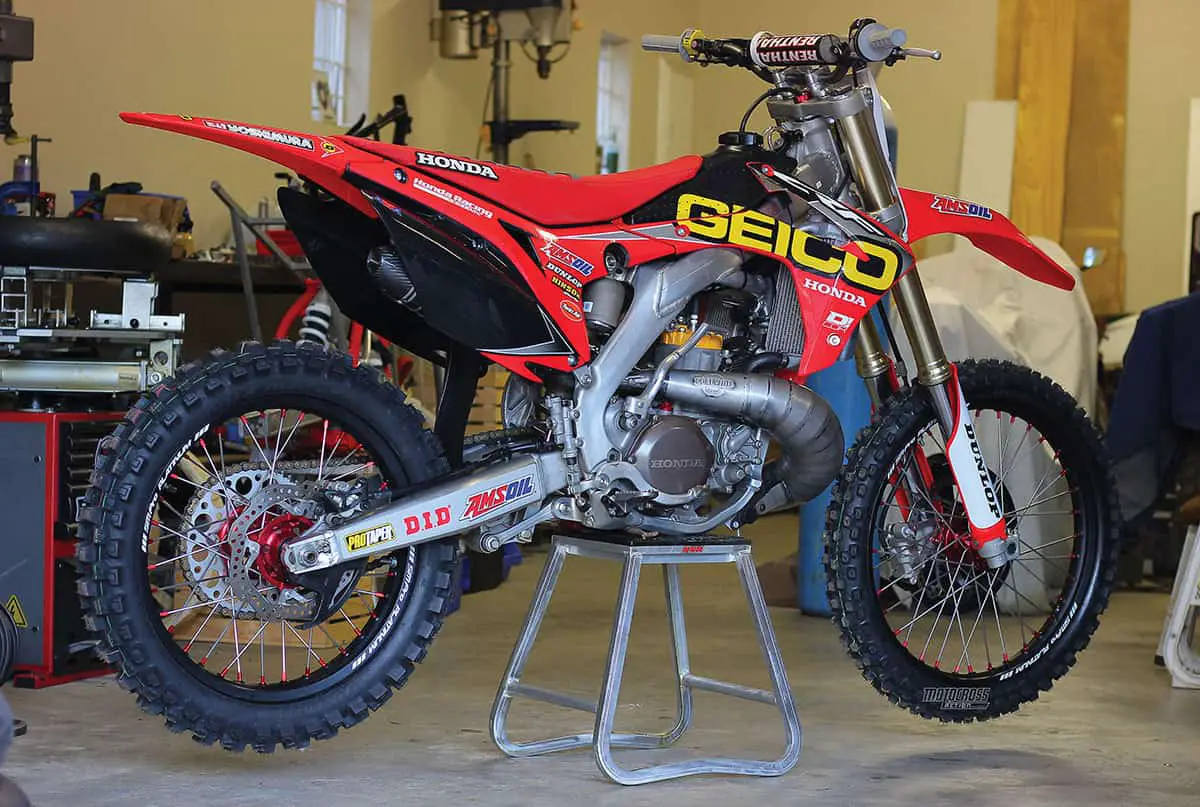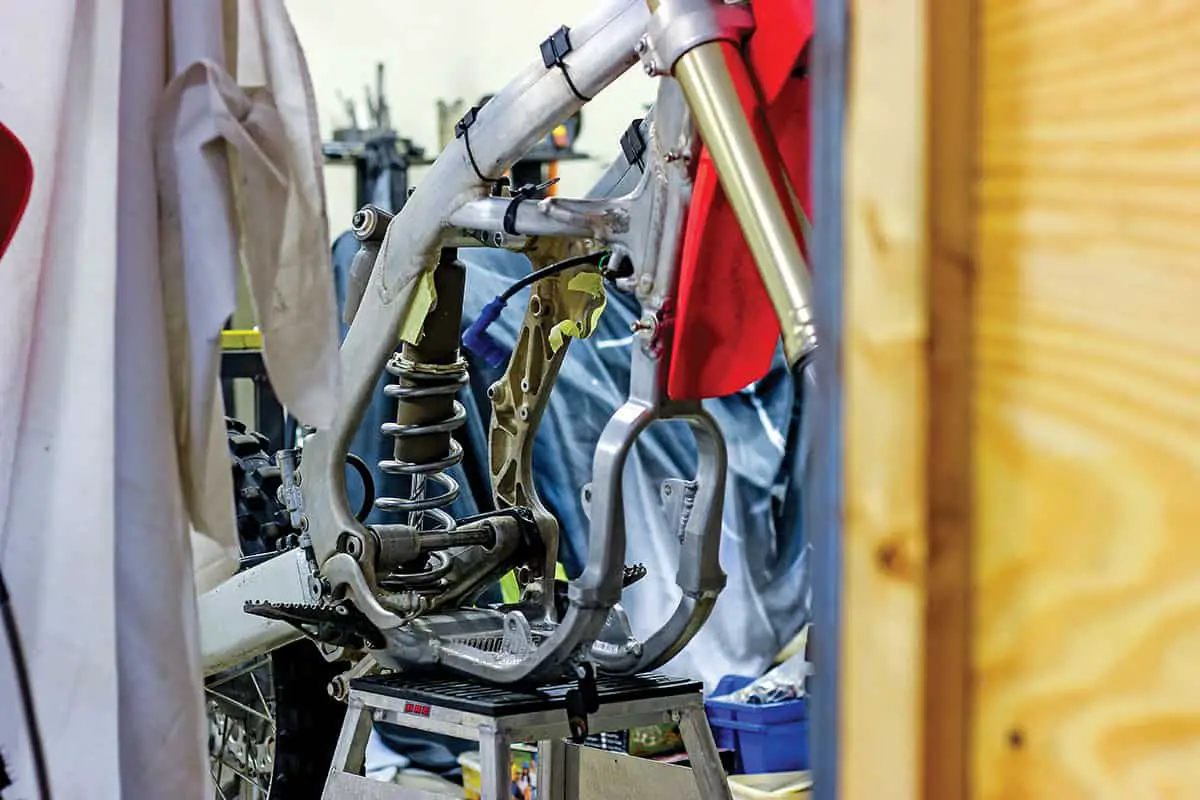ONE MAN’S JOURNEY TO CR250 TWO-STROKE NIRVANA

By John Basher
Just as with other major things in today’s world, there are opposing views in the dirt bike world. There are die-hard two-stroke loyalists and new-age four-stroke aficionados. A line has been drawn in the sand. As the popular saying goes, “You can’t have your cake and eat it too.” Don’t tell that to Justin Steyn, who has managed to do the unthinkable. The South African has blended the lines by shoehorning a 2001 Honda CR250 two-stroke engine into a 2016 Honda CRF250 four-stroke chassis. It took a judicious amount of money, help from a stranger, lots of research and a little bit of luck. MXA sat down with South African Justin Steyn to have him take us through the steps.
WHERE DID YOU COME UP WITH THE IDEA OF PUTTING A 2001 CR250 ENGINE IN A 2016 CRF250? The Honda CR250AF idea popped into my head when my 2011 CRF250 four-stroke was ready to be upgraded. I enjoyed the four-stroke but craved the excitement of a two-stroke again. Believe it or not, the 2016 CRF250 frame I used was the third frame I acquired during the build. I first started with a generation-four 2014 CRF250 frame, but then found a clean 2016 CRF250 came up. I sold the previous 2014 CRF250 engine for three-quarters of what the 2016 bike cost! Building from just a frame up would have been too costly to source all the parts.

TELL US WHY YOU CHOSE THE 2001 HONDA CR250 ENGINE? I read in MXA that the 2001 was the best-performing CR250 two-stroke engine, as it was the last of the cylinder-reed engines before Honda went to the case-reed design with an RC power valve.
How I acquired the engine is actually a pretty funny story. I called a guy who advertised a CR250 engine. It turned out that he had a CR250 engine and was looking for a first-generation CR250 frame. We got to chatting. Lo and behold, we had both come across a 1998 CR250 that was for sale. We met up and paid 50/50 on the 1998. I got the engine and he got the rest. I was happy as long as the engine ran. At that stage I sourced a nice 2001 CR250 head and cylinder. I also purchased all of the Wiseco internals that I could.

WHY DID YOU CHOOSE A CRF250 FOUR-STROKE CHASSIS INSTEAD OF A STANDARD ALUMINUM CR FRAME? I had owned a second-generation CR250 years ago and loved it. Having said that, the whole project was based on building something pretty trick for the same price (or less) than a new CRF450. I’m an absolute Honda nut and will not ride any other brand. I had to make my own CR250, since Honda discontinued them in 2008.
HOW MUCH FABRICATING WAS NEEDED TO PUT THE CR250 ENGINE IN THE FOUR-STROKE CHASSIS? The fabrication wasn’t too complicated. I outsourced the welding and fabrication to a local welder—David from Dreyer Corp. I did some online research of other aluminum frame conversions and learned a lot about them. Basically, the frame’s Y downtube piece needed to be swapped out to allow the head pipe to fit through the frame. The swingarm was spaced using OEM spacers on the CR250 engine, and a new head stay had to be welded in. The exhaust mounts had to be modified, but fitting the carburetor and airbox together was the trickiest bit.

HOW MUCH DID THE TOTAL BUILD COST? I didn’t keep a record of all the costs, in case my wife found the figures! In all honesty, the total price was just below the price of a new Honda CRF450 four-stroke.
WHERE DID YOU SPEND THE MOST MONEY? The engine cost the most, because I really wanted to build a strong powerplant. I ordered all-new Wiseco internals—crankshaft, piston rod, bearings and piston. I also invested in a new 2001 OEM head and cylinder, Keihin carburetor, Moto Tassinari VForce reeds, Intelajet system and a Scalvini pipe.
The head, cylinder and carburetor were sent to Dick’s Racing for mods. They taper-bored the carburetor from 36mm to a 39mm, as well as installed the Quad Flow Torque Wing and Intelajet. Most of these mods were decided on after reading about them in MXA.
The rolling chassis was a steal. It was a Honda demo that a salesman had dropped off a trailer. The bike had some road rash on the master cylinder, front brake lever, side panel and exhaust. It was minor damage, but it caused the bike to sit on the dealer floor for ages. The dealer eventually sold it to me at cost. After I sold the engine, the rest of the bike cost me about $1000. Despite the minor damage, the bike was a low-hour machine. I could tell by the fact that the brake discs and rims were still like new.
LET’S TALK ABOUT THE TRICKY BITS. HOW DID YOU DEAL WITH THE SPACE WHERE THE FUEL PUMP WAS AND INSTALL A FUEL LINE FOR THE CARBURETOR? The pump was easy to remove. I had an aluminum plate fabricated to fit. It bolted right on without issue. There’s an outlet pipe to which the fuel line attaches. Truthfully, that part was rather simple.

HOW DID YOU CONFIGURE THE OLD-STYLE TWO-STROKE AIR BOOT? The Moto Speed Shop did the fitment. We used a CR500 airboot and coaxed it into place with the Keihin carb and OEM CRF250 airbox. The reason we used a CR500 airboot is because sourcing the older CR250 airboot is not too easy. They have become scarce.
DID YOU OPT FOR A HIGH-COMPRESSION PISTON OR GO OVERBORE? We went with a high-compression Wiseco piston at the stock bore. Dick’s Racing increased the compression by milling the cylinder head. Moto Speed Shop balanced the crank and piston. The bike also has a Vortex X10 ignition.
WHAT KIND OF FUEL AND PREMIX ARE YOU RUNNING, AND AT WHAT RATIO? I had some issues with pinging on 95-octane pump gas, so I switched to Avgas. I’m running it at a 40:1 ratio. I live in Johannesburg, South Africa, and it’s 5550 feet above sea level.

DID YOU ACCOMPLISH EVERYTHING YOU WANTED WITH THE BUILD? Yes and no, but for the most part the bike ticks all the boxes. The CR250 chassis has the looks, and the bike has plenty of power. Some think there is too much power! Overall, the bike has the go to match, even if I don’t!
The missing item that I would like to get is some Showa A-kit suspension. I’ve tracked some second-hand kits down, but the exchange rate with U.S. dollars makes it a little too much of a sting for now.
The crazy thing is, I think the new 2018 Honda CRF250 is a stunner. I might want to start a project on one of those.






Comments are closed.